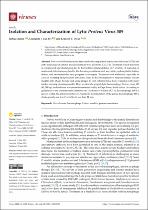| dc.contributor.author | Aaron, Joshua | |
| dc.contributor.author | Dicks, Leon M. T. | |
| dc.contributor.author | van Zyl, Leonardo J. | |
| dc.date.accessioned | 2022-07-12T08:54:37Z | |
| dc.date.available | 2022-07-12T08:54:37Z | |
| dc.date.issued | 2022 | |
| dc.identifier.citation | Aaron, J. et al. (2022). Isolation and characterization of lytic proteus virus 309. Viruses, 14(6), 1309. https://doi.org/10.3390/v14061309 | en_US |
| dc.identifier.issn | 1999-4915 | |
| dc.identifier.uri | https://doi.org/10.3390/v14061309 | |
| dc.identifier.uri | http://hdl.handle.net/10566/7589 | |
| dc.description.abstract | Proteus mirabilis is frequently associated with complicated urinary tract infections (UTIs) and
is the main cause of catheter-associated urinary tract infections (CAUTIs). Treatment of such infections
is complicated and challenging due to the biofilm forming abilities of P. mirabilis. If neglected or
mistreated, infections may lead to life-threating conditions such as cystitis, pyelonephritis, kidney
failure, and bacteremia that may progress to urosepsis. Treatment with antibiotics, especially in
cases of recurring and persistent infections, leads to the development of resistant strains. Recent
insights into phage therapy and using phages to coat catheters have been evaluated with many
studies showing promising results. | en_US |
| dc.language.iso | en | en_US |
| dc.publisher | MDPI | en_US |
| dc.subject | Novosibovirus | en_US |
| dc.subject | Biotechnology | en_US |
| dc.subject | Bacteriophage | en_US |
| dc.subject | Proteus mirabilis | en_US |
| dc.subject | Urine infection | en_US |
| dc.title | Isolation and characterization of lytic proteus virus 309 | en_US |
| dc.type | Article | en_US |

